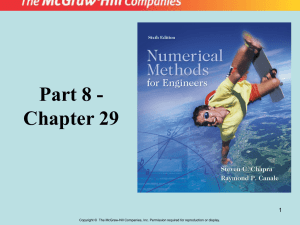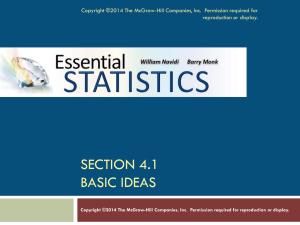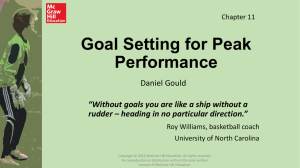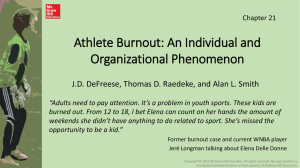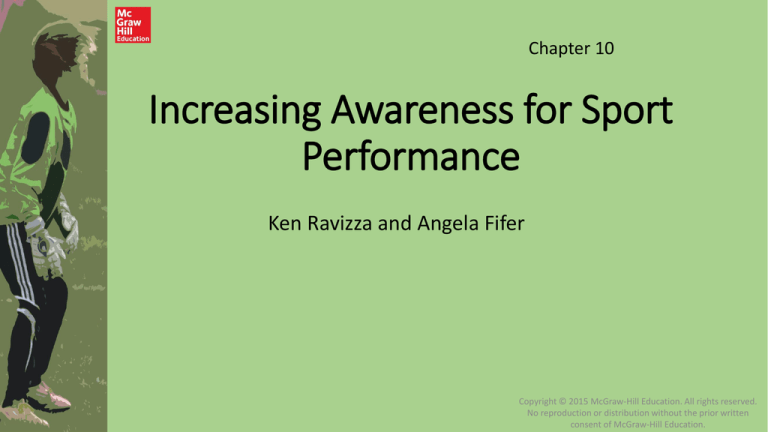
Chapter 10
Increasing Awareness for Sport
Performance
Ken Ravizza and Angela Fifer
Copyright © 2015 McGraw-Hill Education. All rights reserved.
No reproduction or distribution without the prior written
consent of McGraw-Hill Education.
What Is Awareness?
• The first step to gaining control of any
pressure situation
• Athletes must be taught this skill
• Check in on arousal level, emotional state,
thought processes, and focus AND adjust
them according to the situation
• The athlete’s challenge is to focus on
basic skills even when his or her
physiology may increase significantly
Copyright © 2015 McGraw-Hill Education. All rights reserved. No
reproduction or distribution without the prior written consent of
McGraw-Hill Education.
Importance of Awareness
• Basis of most physical skill development and the process of
skill execution
• Lack of awareness is almost always the result of an
excessive end result focus
Copyright © 2015 McGraw-Hill Education. All rights reserved. No
reproduction or distribution without the prior written consent of
McGraw-Hill Education.
Steps in Awareness Process
1. Athlete becomes aware of ideal performance state
and the routine behaviors they are already using to
achieve this state
2. Recognize when no longer in the ideal state
Awareness skills Earlier recognition
3. Implement appropriate interventions to get back
into ideal performance state
Copyright © 2015 McGraw-Hill Education. All rights reserved. No
reproduction or distribution without the prior written consent of
McGraw-Hill Education.
The R’s
• Athletes learn there is
a relationship between
the things they do to
maximize performance
• Emphasizes that they
have control over their
own reactions,
attitudes, and
behaviors
• Learn to let go of the
things outside of their
control
• Responsibility
• Recognize
• Release
• Regroup
• Refocusing
• Ready
• Respond
Copyright © 2015 McGraw-Hill Education. All rights reserved.
No reproduction or distribution without the prior written
consent of McGraw-Hill Education.
The R’s
Copyright © 2015 McGraw-Hill Education. All rights reserved
No reproduction or distribution without the prior written
consent of McGraw-Hill Education.
Training Awareness Exercises
• Have athlete write a scouting report on his/her
strengths and weaknesses
• What is the opponent saying about them? What would
they like the opponent to say about them?
• Establish awareness routines
• E.g., set two goals for practice when putting on shoes
and then evaluate how well the goals were addressed
when taking shoes off
Copyright © 2015 McGraw-Hill Education. All rights reserved. No
reproduction or distribution without the prior written consent of
McGraw-Hill Education.
Training Awareness Exercises
• Learning the basics
• Requires totally focusing attention on
the task
• Incorporate awareness training with
physical skills training and warm ups
• Need progression of skills vs. “All-orNone Syndrome”
• 1-5 evaluative feedback
• Play the “Edge of Peak Performance”
• Blindfolded run
• Assess performance through
psychological questionnaires and
physiological monitoring
Copyright © 2015 McGraw-Hill Education. All rights reserved. No
reproduction or distribution without the prior written consent of
McGraw-Hill Education.
Training Awareness Exercises (cont.)
• Increase awareness of arousal effects
and manage as needed
• Monitor and alter arousal via traffic light
analogy
• Periodically monitor arousal level
• Green light = optimal, continue with what doing
• Yellow light = possible caution, observe more
carefully
• Red light = “stop”, change either or
• Goal is to catch when changing from green to
yellow vs. when already red
• Keep a sport journal
Copyright © 2015 McGraw-Hill Education. All rights reserved. No
reproduction or distribution without the prior written consent of
McGraw-Hill Education.
Training Awareness Exercises (cont.)
• Use imagery to relive positive
past performances
• Contrast peak performance with
poorer performance
• Conduct group discussions
• Assess strengths and
weaknesses
• Ask questions about arousal and
confidence levels, stressors, etc.
Copyright © 2015 McGraw-Hill Education. All rights reserved. No
reproduction or distribution without the prior written consent of
McGraw-Hill Education.








